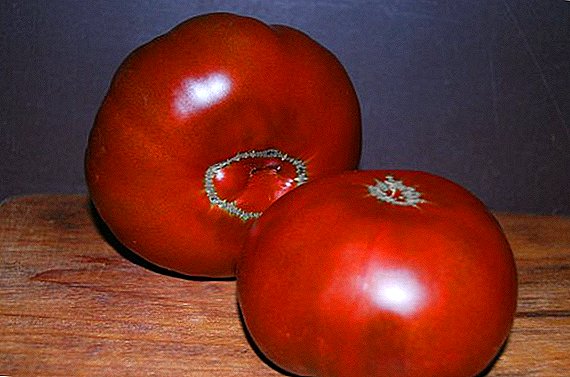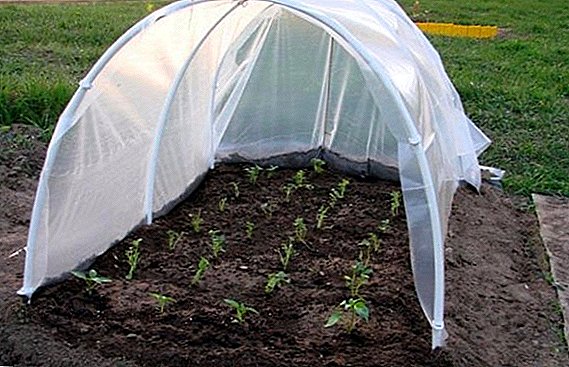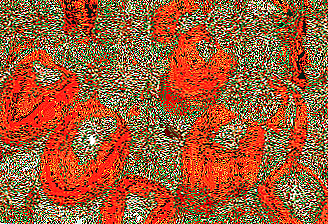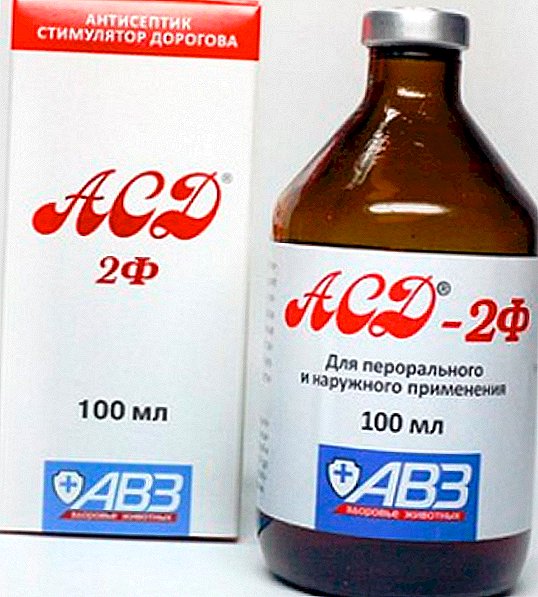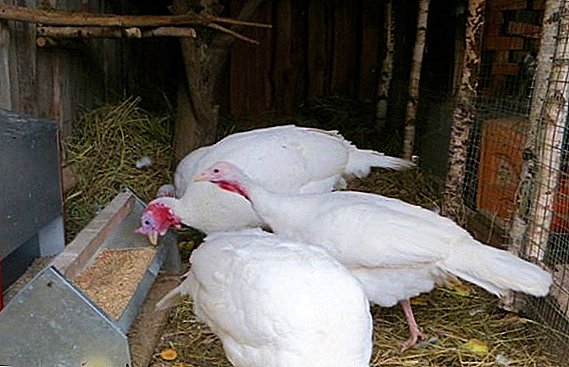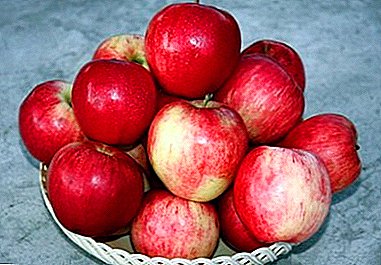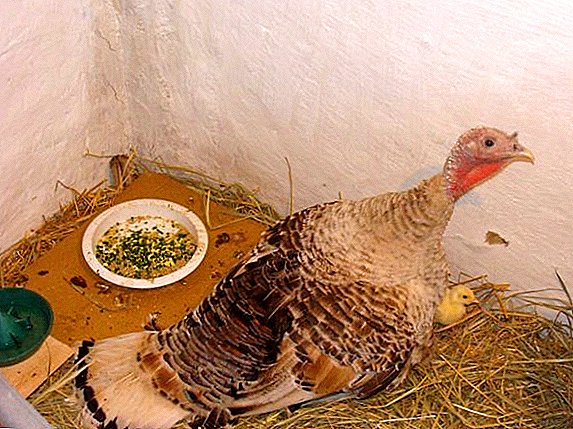 The organization of proper nutrition of turkeys in the household is the key to high productivity of this bird. The diet of a turkey can vary at different stages of its content and at different times of the year. Let us understand the features of feeding already adult animals.
The organization of proper nutrition of turkeys in the household is the key to high productivity of this bird. The diet of a turkey can vary at different stages of its content and at different times of the year. Let us understand the features of feeding already adult animals.
How to feed adult turkeys
The diet of poultry must meet its needs for proteins, amino acids, fats, carbohydrates, fiber, vitamins and minerals. The composition of feed, which give the bird in winter, is somewhat different from the composition of summer feed.  In the turkey diet, the various components are distributed approximately in this ratio:
In the turkey diet, the various components are distributed approximately in this ratio:
- grain crops (wheat, oats, barley, maize, peas, etc.) - up to 70% of the total mass of the daily ration;
- grated vegetables (carrots, beets, cabbage, boiled potatoes, etc.) - up to 15%;
- herbs, both fresh and dry (alfalfa, clover, etc.) - up to 5%;
- fodder yeast - no more than 5%;
- products containing calcium (chalk, shell rock, etc.) - up to 4%;
- fish meal - up to 3%;
- meat and bone meal - up to 3%;
- sunflower meal or soybean meal - up to 1%;
- premixes - up to 1%;
- food salt - about 0.5%.

In spring and summer
Aside from specialized feed, the most preferred is a diet consisting of wet mash. Blender is a mixture of several components (mainly crushed grain) with the addition of water. As an example, you can prepare this mash:
- crushed barley - 40%;
- crushed oats - 20%;
- crushed corn grain - 20%;
- wheat bran - 15%;
- sunflower cake - 5%
Agree that turkeys need to provide a balanced and varied diet. Read about how to make a diet for turkeys at home.All this is mixed, salted, some fish meal and chalk are added, water is added to moisten. Boiled crushed potatoes (about 15% by weight of the mixture) and fresh greens (about 5%) are additionally added to this mixture. The recipe can be changed, for example, use buckwheat instead of oats or grated fresh carrots instead of potatoes.

In winter
At this time of year turkeys are fed three times a day. Winter diet has some differences from the summer, namely:
- fresh greens are replaced by grass flour or chopped hay, dried brooms made of nettle, linden or birch branches have worked well;
- To saturate the body of the bird with vitamin C, pine, fir or spruce needles are added to the food (approximately 10 grams per individual);
- lack of other vitamins is replenished with fodder yeast or germinated grain;
- it is highly desirable to add grated sugar beets or pumpkins to the feed during this period;
- some gravel is added to the feed, this ensures normal digestion for the bird.

Differences in feeding turkeys in different periods
The diet of turkeys has its own characteristics in different periods of the life cycle of this bird, namely: at the laying stage, during the breeding period and in the process of feeding the birds before slaughter. Consider the feeding habits of the birds in each of these periods in more detail.
One of the conditions for the good development and growth of birds is the constant availability of water in their access zone. Read about how to make their own drinkers for turkeys.
During the laying period
To ensure good productivity of turkeys, fertilization and hatchability of eggs, balanced feed is required. The approximate composition of the mixtures during this period is as follows:
- grain - up to 65%;
- bran - up to 10%;
- cake or meal - up to 10%;
- fish or meat and bone meal - up to 8%;
- greens or vegetables (preferably carrots or beets) - up to 10%;
- chalk or shell rock - up to 5%.
 The optimal diet is as follows: twice a day, in the morning and at lunch, the birds are given wet mash, while the rest of the time there should always be dry food in the feeder.
The optimal diet is as follows: twice a day, in the morning and at lunch, the birds are given wet mash, while the rest of the time there should always be dry food in the feeder.Poultry farmers should consider at what age turkeys begin to be born, how to lay eggs under the turkey, and also read about the benefits and harms of turkey eggs.
In the tribal period
During this period, the behavior of males changes, their appetite decreases. In order to prevent a decrease in the weight gained by males, some changes are made to the diet of the bird. In particular, the amount of grain of leguminous crops, greens and vegetables (mainly carrots and beets) is increasing, cottage cheese is added to the feed, and meat and bone meal or fish meal are necessarily added to the feed.
Fattening to slaughter
Usually increased fattening of turkeys begins 25-30 days before slaughter. During this period, the bird is fed strictly at a certain time, in the morning and in the afternoon it is recommended to give it wet mash, in the evening - a cereal mixture.  In addition, if possible, meat wastes are added to the feed (they are boiled), as well as boiled chopped acorns or walnuts (approximately 50 grams per day per individual) - this will improve the quality of turkey meat.
In addition, if possible, meat wastes are added to the feed (they are boiled), as well as boiled chopped acorns or walnuts (approximately 50 grams per day per individual) - this will improve the quality of turkey meat.
In addition, wheat flour is added to the feed (up to 10%). Some poultry farmers recommend giving turkey dumplings, about 250 grams per day per individual. True, you have to put your hands in dumplings in the bird's beak, which is not easy to do without some experience.
Initially, the amount of feed for turkeys fed for meat remains the same (for a year-old individual it is about 400 grams of feed per day), only its composition changes, as described above. But gradually the bird begins to be restricted in movement, and 5 days before slaughter it is desirable to immobilize it.
Did you know? Turkeys are the second largest poultry after the ostrich. The weight of adult males of some turkey breeds can reach 30 kg.
Together with these measures, increase the daily rate of feed to about 800-850 grams. To speed up the process of weight gain will help specialized feed. 
Vitamin and mineral supplements
As such additives, industrial products can be used - these are specialized protein-mineral vitamin supplements (BMVD). They are used according to the instructions. But, in addition, the following components are used as a source of essential vitamins and minerals:
- yeast and germinated grain are a source of vitamins A, B, E, H;
- needles, as well as dried brooms of nettle, birch, linden - a source of vitamin C in the winter;
- an excellent vitamin supplement is hay from alfalfa or clover (vitamins A, C, B, P);
- meat and bone meal and fish meal supply the body of the animal with phosphorus, potassium, calcium and amino acids;
- salt is a source of sodium;
- chalk, shell rock, eggshell - sources of calcium.

What if the birds do not gain weight
In some cases, turkeys stop gaining weight. First you need to find out if this is a manifestation of the disease.
If symptoms of diseases are not detected, it is necessary to analyze the conditions of their housing - this bird is sensitive to the value of temperature and humidity in the room, the presence of good ventilation. If conditions are far from optimal, turkeys lose their appetite and, consequently, their weight.
It will also be useful for you to learn how to properly feed the poults, as well as read about how to make a diet of daily turkey poults at home.
In addition, the reason for stopping weight gain can be an unbalanced composition of the feed - the composition should be carefully analyzed and, if necessary, make changes in the diet. A good appetite stimulant is chopped green onions. It is better to add it in feed in the morning and in the evening. 
Than you can not feed turkeys
There are products that should never be given to turkeys:
- any moldy food;
- soured wet mash;
- some types of herbs (belladonna, cycuta, hemlock, wild rosemary);
- too salty or sweet foods (for example, confectionery).
It is known that turkey meat is very nutritious and at the same time low-calorie. We advise you to consider all the features of growing turkeys for meat.
Turkeys are pretty picky about nutrition. They need a balanced diet and regular feeding at about the same time. But to choose the best diet for this bird is easy, because the products that make up a balanced turkey feed are widespread.
If we take into account all the nuances of feeding, as well as organize the proper conditions of housing, then there will be no problems with feeding this bird.


